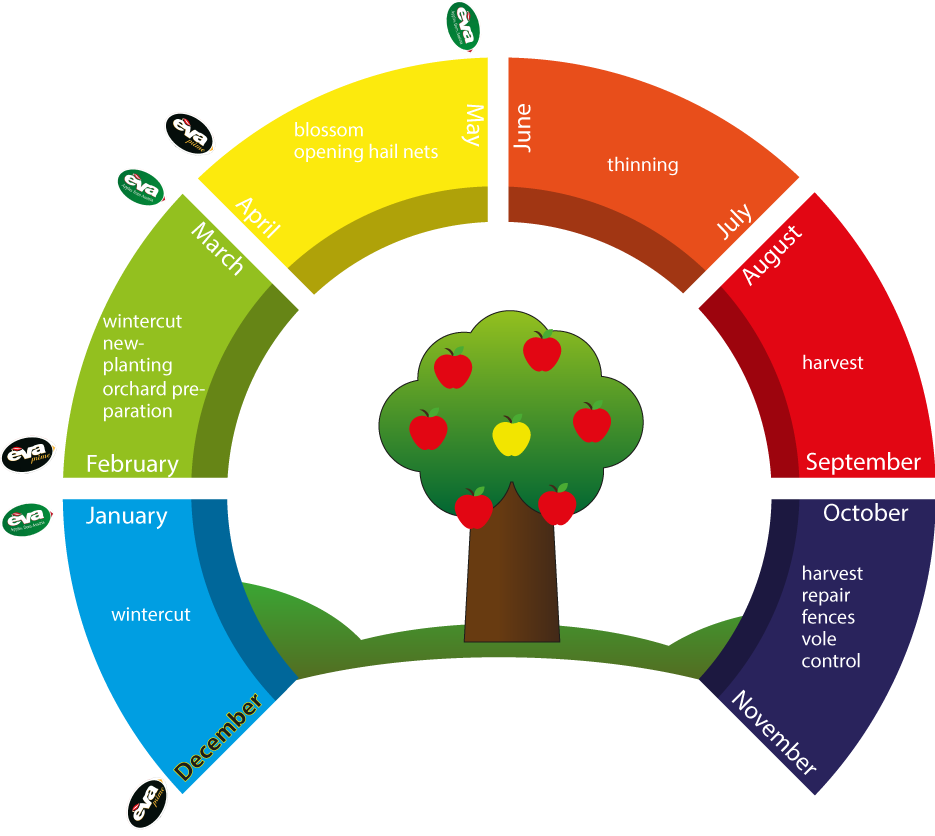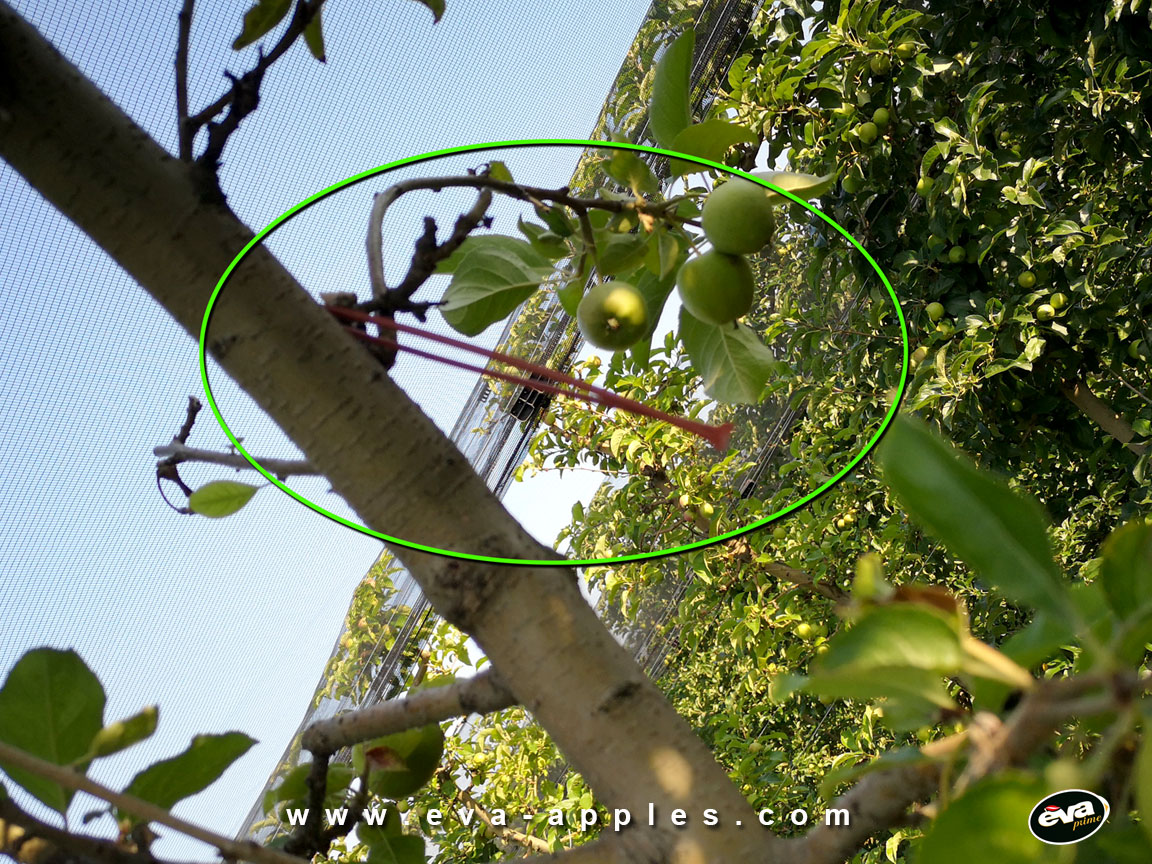An Appleyear – April & May 2019
EVA-Apples: Hello Karin, thank you very much for your time! The last time we met we were watching you planting the new Fengapi (Tessa) trees. Please tell us, what has happend in the meantime?
Karin: It has been a while and many things happend in the meantime. First, I want to point out that our new trees are already growing well. Besides that we have started the more labor intensive work in our orchards. We have passed the blossoming, closing of the hail nets, many phytosanitary treatments, some sleepless nights because we expected frost which also includes the usage of our frost protection, then we have already adjusted our mating disruption for the codling moths, we did some mulching, took care of the tree stripes and much more.
EVA-Apples: In April Styrian landscape was enchanted by the beautiful blossoming apple trees. Please explain us what is essential during this stage, what are the specific stages of blossoming and what is the so called “king Bloom”?
Karin: For me, this is the most Beautiful stage of the Season. Here from our farm you can see all those trees which are fully covered with beautiful blooms. The blossoming is basically splint into different stages. At first, we have the red flower bud. In this stage you can only see the tip of the flower bud. After that the blossom starts until it has reached the stage of full flowering. After the peak that blooming is declining. Depending to the weather conditions this can be a quicker or slower process. If there are perfect conditions (warm temperatures, sufficient rainfalls, some wind) this is of course a big benefit for us.
The king Bloom is a truss of 5 Flower buds. The middle Flower bud is the so called king Bloom. The king blom in most cases is a little ahead in its development and that’s why it’s more likely it is developing a nicer and bigger apple.
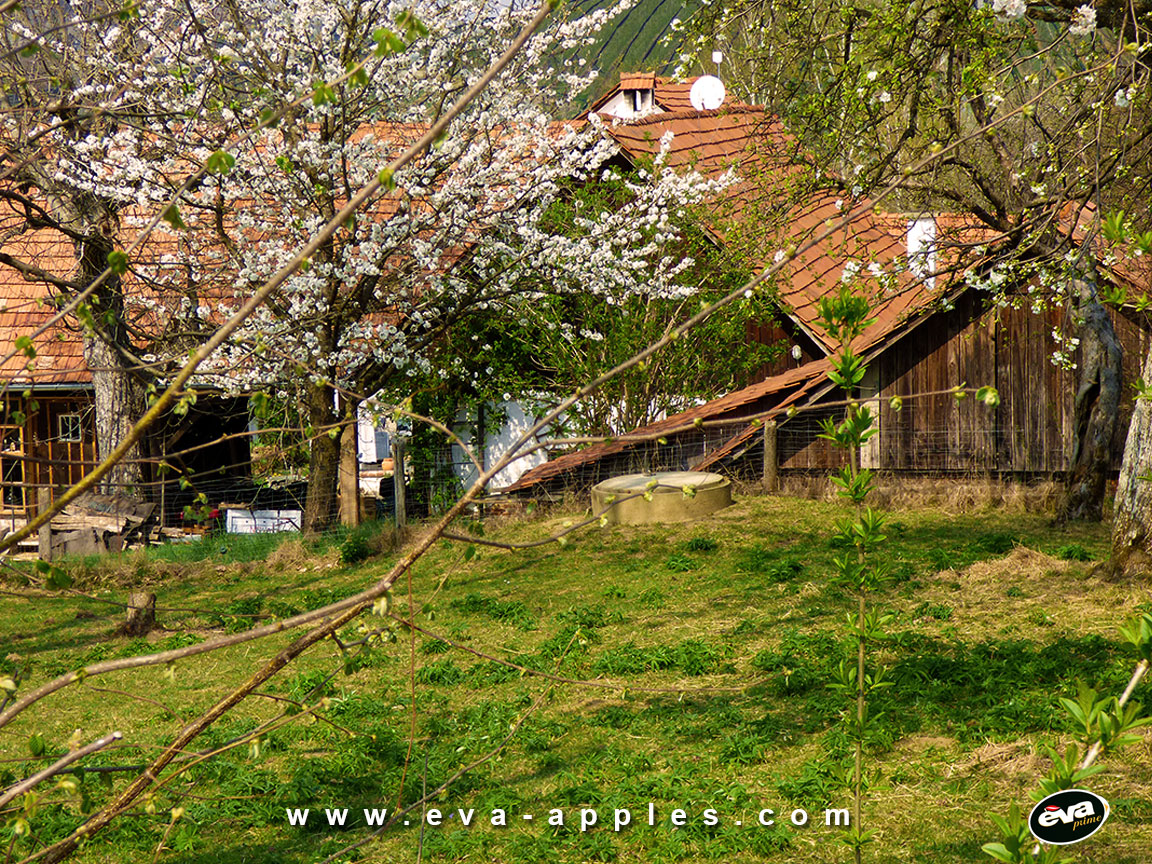
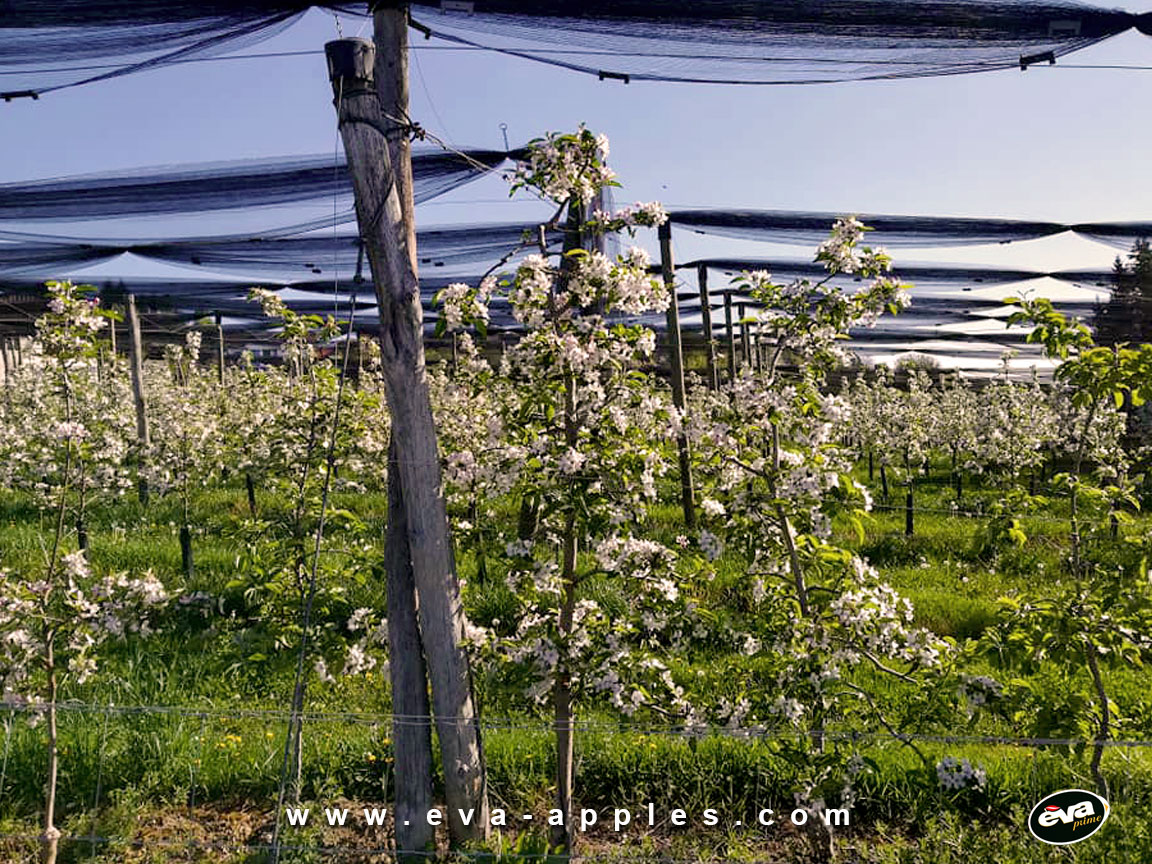
EVA-Apples: One big topic in the media lately was the bee death. As far as I’m aware there are apples producers who borrow hives during blossom. Are you doing something similar or are you putting your fate into natures hand?
Karin: Lucky us, one of our direct neighbors is a beekeeper and he has put his hives close to our orchards. So at the moment we are all set with the Situation as it is. We really appreciate all his enormous efforts because it’s a very imporant and big help for us.
EVA-Apples: Could you kindly let us know more about the topic alternation? What exactly is this?
Karin: Alternation meanst that in fruit production we have a yield that varies from year to year. So, in one year the tree has tons of apples, that following year the trees would be almost not carrying any fruits at all. It is now our task to make sure that in a high yield year we make sure that we get rid of some blossoms or early fruits in time. That is the basis for a good flower bud formation in the next season. That’s the way how we can take influence and get some kind of regularity in regard of the yield. But also the alternation varies from variety to variety. Not every variety has a tendency for alternation.
EVA Apples: Are there things you can do during blossoming in order to influence the product quality in a positive way?
Karin: Yes, I can. For example, one thing is to handle the alternation correctly. In addition, you should make sure that there are enough bees or bumblebees for pollination. There are other measurements before or during blossoming to control amount of fruits on the tree. If you control the amount of grwoing fruits you can relive the tree in time in order the tree can develop less but nicer fruits. That’s what we call “thinning”.
EVA-Apples: End of May there was again another frost wave rolling over Europe. Which preperatives did you take? What are you doing once you are aware that a frost night is going to be ahead? By the way, did you have any frost damages?
Karin: As we have installed a frost protection in 2017 we more or less just need to make sure and check if our forst protection is working and running correctly. Once we have controlled the functionality and we know that a frost night is ahead we are in a permanent alert situation. We Need to get up a couple of times each night and are checking the outside temperature. Onces we see that temperature has reached a critical point we are starting our frost protection. This year we have managed the whole situation very good, wherefore we didn’t have any frost damages.
EVA-Apples: May usually is also the time when the first thunderstorms arrive? Lately they are coming togheter with strong rains and hail. At what time are you closing the hail nets in the orchards and what effect has the closed hail net on the development of the fruits?
Karin: We are closing the hail nets once the blossoming is over. The bees would have a hard time finding their way out of the orchareds if hail nets are closed. That’s why we are waiting until they have their job done. But as we are also having a frost protection System we also wait until the so called Ice Saints are over. Once These days have pased the risk of late frosts is sinking and we can close the hail nets. Because of the heavy weight of the hail/ice the nets would just crack under the enormous weight. But in general it’s important to close the nets as quickly as possible and not lose any time. Since , once the blossoming is over there are already small fruits on the trees and if hail would hit them they would be damaged. Of course, the disadvantage of the hail nets is, that there is not too much light coming through to the hail nets. But on the other hand, this is an advantage that fruits can’t get sun burned.
EVA Apples: Rain is important and good for the growth of the fruits. We had now some time with a lot of rain. What is your experience, isn’t too much rain also a potential threat for diseases and funguses?
Karin: Yes, too much rain is a potential risk factor for funguses and diseases. That’s why we Need to treat the orchards with phytosanitary measurements to prevent having a complete loss of the crop. Also if you are not setting the right measurements you will have additional problems the season after too. So that’s why it’s inevitable to do phytosanitary measurements before rain is expected.
EVA Apples: In the meantime we can already see some tiny apples on the trees. This is the first stage to influence the quality of the oncoming crop actively. How are you making sure, that only the best apples are staying on the trees?
Karin: Exactly. This is the thinning I was talking About earlier. Me and my Workers are going through the orchards and manually pick some of the smallest apples on the trees and are that way reducing the number of apples, in case this is necessary.
EVA Apples: Please also let us know what is the so called “June drop”? What is this and isn’t this also something which is good for you?
Karin: Yes, June drop means, that the trees are losing fruits themselves. There are certain measurements to help the tree for a stronger drop of fruits. This is helping us afterwards to be quicker during manual thinning. Because then we only need to put the focus during thining on the quality aspect and not on quantity reduction. So, over all, up to a certain amount June drop is something good for us.
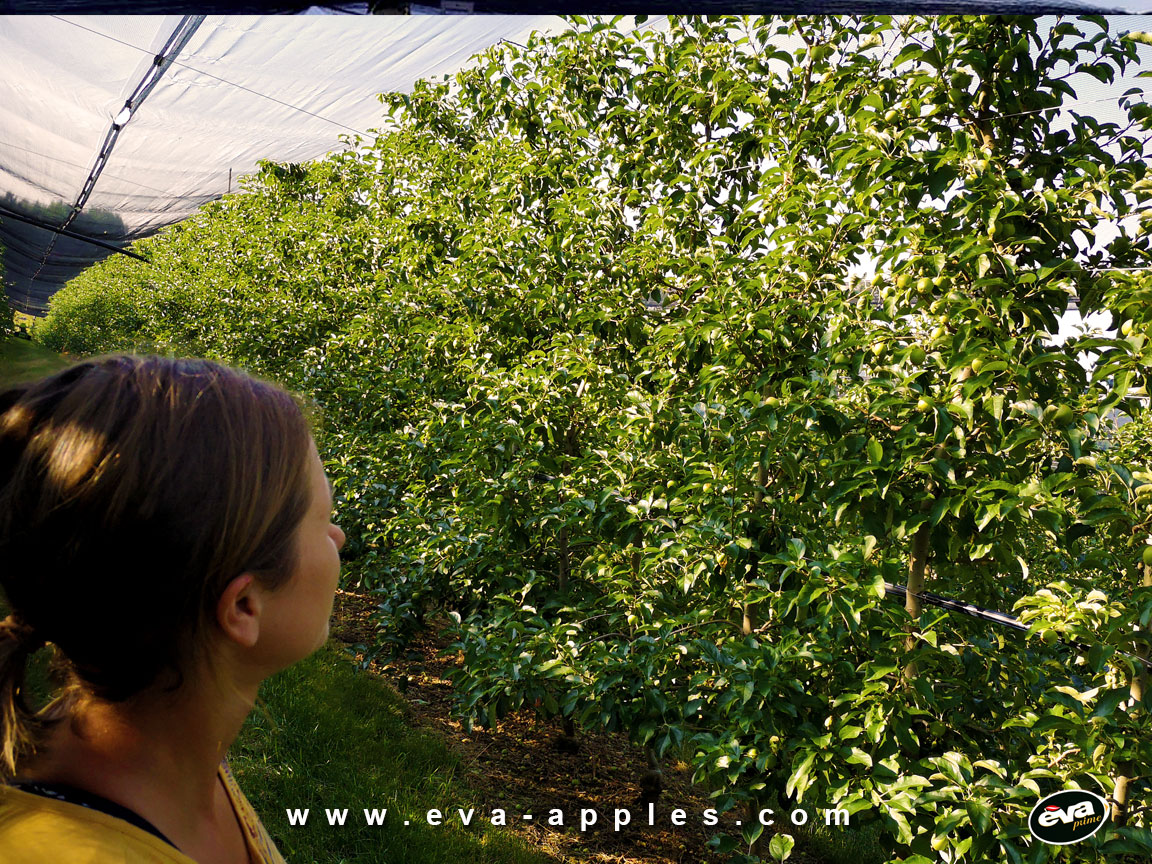
Klicke hier, um Ihren eigenen Text einzufügen
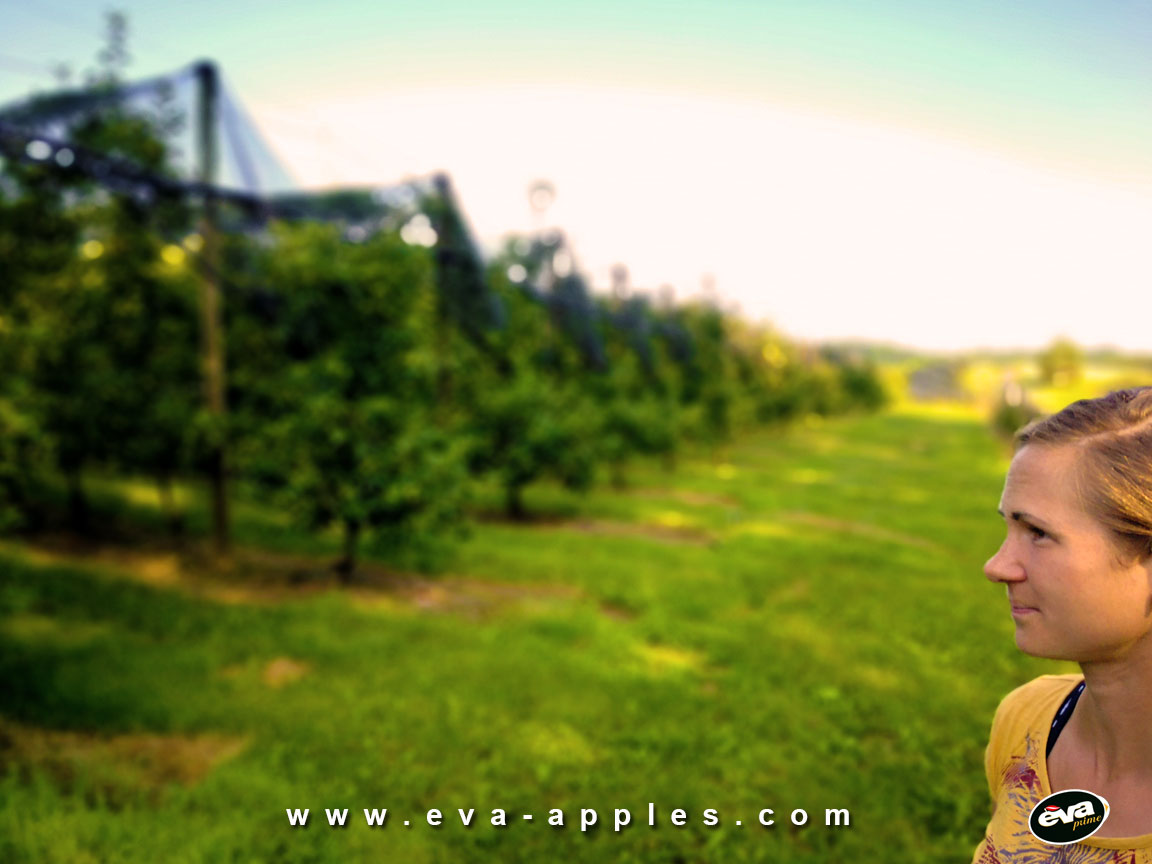
EVA-Apples: And at the end, it’s time for your question?
Karin: Lately there are more and more articles about a decline of apple consumption. What do you think should be done to increase apple consumption again? Do you think it needs a new and modern adverstisement campaign?
EVA-Apples: This Question I would like to answer only out of my personal perspective. I tink that currently there is a huge standard assortment of fruit and vegetables which are available all year long. I don’t think it just needs more advertisment but also even more more awareness of where our food is coming from. I aussume that only a small and critical part of consumers is paying high attention to the question form where their food origins. I’m not sure if many consumers know, at what time which fruit or vegetables are harvested within the region they are living in. If there are strawberries in February and other berries available almost all year long, the competition in fresh produce is simply enormous. I’m not sure if many are Aware, that this fruit then mainly is not of Austrian orgin or at least from neigbhoring countries. But this is also an aim of our blog to put more awareness of where our apples are coming from and how much work and efforts you have to invest (time, money and work) in order we are getting those wonderful apples.
Besides that I think that it’s currently a trend to lable mainly exotic fruits with the term “superfood”. Whereas what is grown and produced here is mundane every day stuff and Standard. I personally don’t understand why a Goji Berry is so much more superfood than for example Kraut or an apple. But also here, I assume, as with many other things it is, that the grass is always greener on the other side.
If we take a look on us I think we also should put more Focus on consistent inner quality of our apples. Whoever once or twice bought a starchy apple will think twice of what to buy the next time he is buying fruit. If the quality is not at constant high Level, I think it will be difficult to compete against all the other fruit offers.
With the newly founded platform for EVELINA Austria (www.evelina.at) we want to make a brought and sustainable impact. For all of us it’s very important to bring Forward especially the regional aspect of EVELINA. With Eveline Wild we have won a very pleasant and local testimanial for our campaign. I’m sure we are on the right track. A regional club brand which is grown in Austria for Austria. The main competitor in Austria in this segment, which is well known because of its colorful presentation and which also has a high brand awareness is on the other hand only grown outside of Austria as has to be imported the whole year. I’m not sure if all Austrian consumers are aware of this.

